TENTH ANNUAL REPORT OF THE MASSACHUSETTS AVIAN RECORDS COMMITTEE
by Marjorie Rines, Secretary
originally published in Bird Observer (April 2006)
In the December 2004 issue of Bird Observer (Vol. 32, No. 6), a panel of experts combined to predict the next new species to appear in Massachusetts. Since the last Annual Report in April 2005 the MARC has accepted three new species, two of which appeared on this list: Bell’s Vireo (third on the list) and Black-tailed Gull (fourth on the list), along with a 2001 report of a European Turtle-Dove. This brings the state total to 484 [author’s note, originally published incorrectly as 483 species] species.
Records accepted by the MARC
Cackling Goose (Branta hutchinsii), #05-27, Great Meadows NWR Concord (Middlesex), D. Scott, many photographers†. As was noted in the Ninth Annual Report (see Bird Observer, Vol. 33, No. 2), in 2004 Cackling Goose was split from Canada Goose (B. canadensis). Each of the resulting species has numerous subspecies, and differentiation is difficult, particularly since many birders have given little attention to these prior to now. The Concord goose was photographed extensively and seen by many birders, and the Committee was convinced that it was correctly identified as the hutchinsii subspecies of Cackling Goose. (First ballot. Vote: 8-1)
Ross’s Goose (Chen rossii), #04-24, October 21-23, 2004, Gill (Franklin), M. Fairbrother, M. Taylor*, S. Smolen-Morton*, P. Brown†, et al. This individual was discovered at Turners Falls, a lake-like opening in the Connecticut River only ten miles north of the location of the first occurrence of this species in Massachusetts in Sunderland in March of 1997. Written documentation and photographs clearly eliminated Snow Goose or a hybrid individual. Only one other Ross’s Goose has been reported between these two sightings, an individual at Chilmark, Martha’s Vineyard in October of 2001. (First ballot. Vote: 9-0)
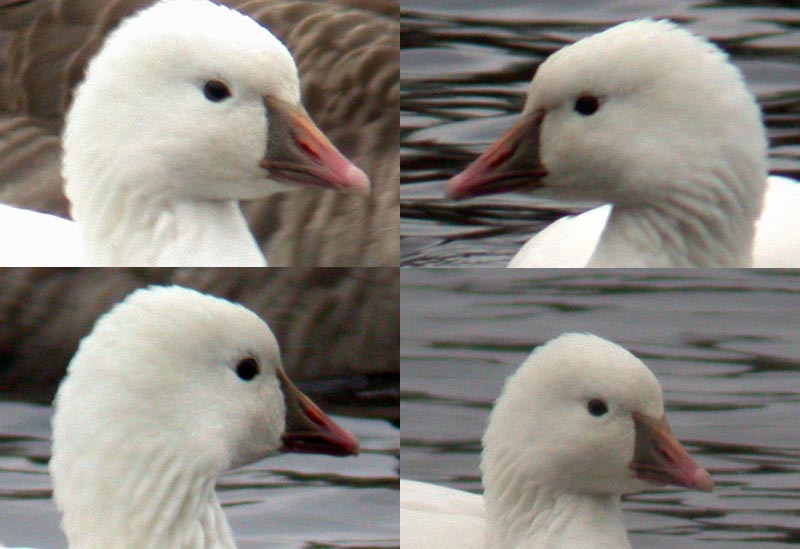
Photo by Phil Brown.
Barnacle Goose (Branta leucopsis), #04-05, April 15-16, and 24, 2004, West Newbury (Essex), T. Wetmore*, D. Larson†. The identification of this bird was never in question, but as with all uncommon waterfowl its origin had to be considered. The first record of Barnacle Goose to be unconditionally accepted by the MARC was in February of 2002, a winter when there was a rash of sightings along the eastern seaboard, and the Committee believed this demonstrated a pattern of true vagrancy. The timing of this sighting during spring waterfowl migration also indicated the probability of wild origin. (Second ballot. Vote: 9-0)
Pacific Loon (Gavia pacifica), #04-26, November 17, 2004, Mashpee (Barnstable), M. Lynch and S. Carroll.* The description clearly eliminated the possibility of other loon species, and the timing of the sighting was appropriate for its occurrence in the state. (First ballot. Vote: 9-0)
Yellow-nosed Albatross (Thalassarche chlororhynchos), #05-06, May 29, 2005, Tuckernuck Island (Nantucket), Richard R. Veit. The observer described how he was casually observing some gulls and recalled mentally thinking how much a Great Black-backed Gull resembles an albatross, when he suddenly realized one was an albatross. The bird was cruising along the southern shore of Tuckernuck Island, making at least five round trips, even occasionally vocalizing. He also took a number of diagnostic photographs, the first photos ever taken of an albatross in Massachusetts (see Bird Observer, Vol. 33, No. 5). (First ballot. Vote: 9-0)
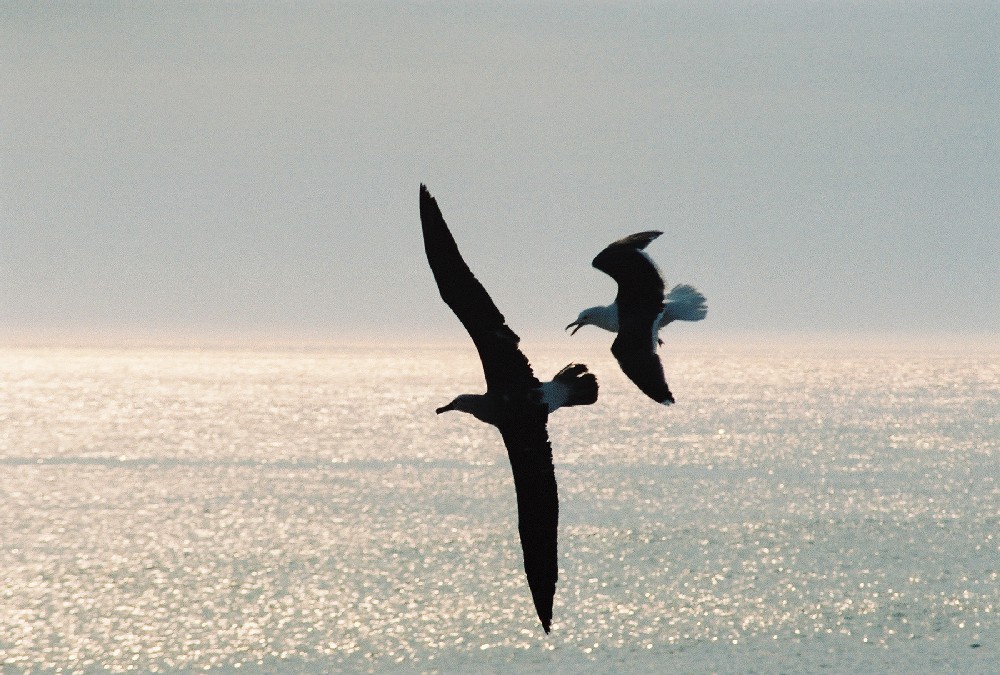
Photo by R. Veit.
Band-rumped Storm-Petrel (Oceanodroma castro), #05-25, August 27, 2005, Hydrographper Canyon, G. Tepke*†. An astute birder reviewing photographs taken on a deepwater pelagic birding trip, realized that he had fortuitously obtained a series of images of a Band-rumped Storm-Petrel. Only a handful of other birders had noticed this bird during the cruise, and given the brief view that they had, were left with the unsatisfying feeling of seeing “something different.” Once again, a digital camera in the hands of a skilled photographer and an observant birder nailed another Massachusetts rarity. (First ballot. Vote: 9-0)
American White Pelican (Pelecanus erythrorhynchos), #04-22, December 5, 2004, Provincetown (Barnstable), S. Landry† et al. (First ballot. Vote: 9-0). #04-21, December 7, 2004, Woburn (Middlesex), M. Rines* (First ballot. Vote: 9-0). #05-17, June 29, 2005, Plum Island, J. Nelson*, D. Noble (First ballot. Vote: 9-0). A report of five birds in Provincetown was unquestionably substantiated by a photograph of three of the birds flying by Provincetown’s signature building, the Pilgrim Monument. The individual seen in Woburn two days later may well have been part of this group, as may have been other undocumented sightings that were reported in and around Massachusetts at this time. Observers at Plum Island specifically watched a single bird standing and preening, and generally giving excellent views of all field marks.
Magnificent Frigatebird (Fregata magnificens), #05-21, July 22, 2005, South Beach Chatham (Barnstable), G. Hirth, R. Merrill*†. The observers discovering this female frigatebird were lucky enough not only to find it, but to photograph it through binoculars. They were aware of other frigatebird species previously recorded in in North America, and carefully noted the black head and throat and white breast patch, marks that effectively eliminated Lesser Frigatebird (F. ariel) and Great Frigatebird (F. minor) as alternative possibilities. (First ballot. Vote: 8-1).
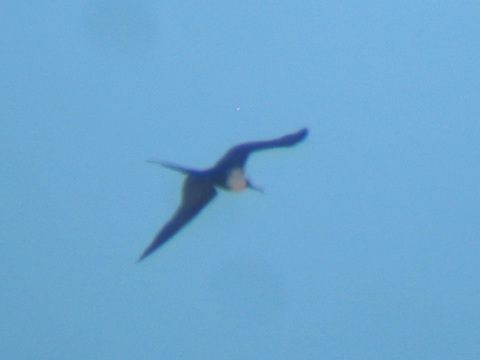
Photo by R. Merrill.
Least Bittern (Ixobrychus exilis), #05-03, February 23, 2005, Boston (Suffolk), D. Swenson†. A male captured on Commonwealth Avenue, and later delivered to the Tufts Wildlife Clinic was only the second January record of this species for Massachusetts. (First ballot. Vote: 9-0)
White-faced Ibis (Plegadis chihi), #05-12, April 25-28, 2005, Plum Island, D. Noble et al., J. Berry*, T. Wetmore*, P. Brown† (First ballot. Vote: 9-0). #05-13, May 5-28, 2005, Newbury and vicinity, F. Vale*, P. Brown†, (First ballot. Vote: 9-0). This western vagrant is extremely rare in Massachusetts, with only four or five previous records (all but one in Essex County). It was therefore big news when the Plum Island bird was discovered in April. Only a week later, birders closely examining a flock of Glossy Ibises in Newbury picked out a White-faced Ibis and assumed that it was the same individual, until photographs revealed that two individuals were involved. The probability of two White-faced Ibises occurring so close to one another, both geographically and temporally, yet not associated, practically defied belief. Fortunately, photography of rare birds has become so commonplace that, combined with the advent of digital imagery and “digiscoping” (digital photography through a telescope), confirmation of such an unlikely coincidence was able to be established beyond a doubt.
Wilson’s Plover (Charadrius wilsonia), #04-23, June 14, 2004, Ipswich Crane Beach (Essex), S. Maddock† (First ballot. Vote: 9-0). #05-10, June 8, 2005, South Monomoy (Barnstable), R. Merrill* (First ballot. Vote: 9-0). #05-14, June 11, 2005, Nantucket (Nantucket), E. Ray† (First ballot. Vote: 9-0). #05-18, July 5, 2005, South Monomoy (Barnstable), R. Merrill*† (First ballot. Vote: 9-0). #05-18B, July 11-22, 2005, Chatham South Beach (Barnstable), J. Trimble† (First ballot. Vote: 9-0). Wilson’s Plover was at one time nearly annual in Massachusetts, but sightings have declined over the past ten years, with only five reports since 1994. The 1994 Crane Beach bird was discovered just over a year after one was reported from the same location on June 4, 2003 (although details were not submitted to the MARC). In 2005 there was a rash of sightings probably involving four individuals between Chatham and Nantucket. The first bird was a female at South Monomoy on June 8. The second was a male on June 11 at Nantucket. On July 5 another plover was discovered on South Monomoy, this time a male, then, from July 11-22 a male was seen regularly at South Beach in Chatham. All birds except the female were photographed, and minor plumage variations in these photos suggested that different individuals were involved.
Little Stint (Calidris minuta), #05-23, July 20-25, 2005, Chatham South Beach (Barnstable), R. Clem, N. Bonomo*†, J. Trimble† (First ballot. Vote: 9-0). #05-24, July 24-25, 2005, Chatham South Beach (Barnstable), J. Trimble†, B. Nikula*†(First ballot. Vote: 9-0). Several experienced birders observed a Little Stint on South Beach in Chatham, July 23-24. Personal observation and photographs taken on both days suggested that two different individuals might have been present, however variations in light and angle in the photographs left room for question over how many birds were actually involved.
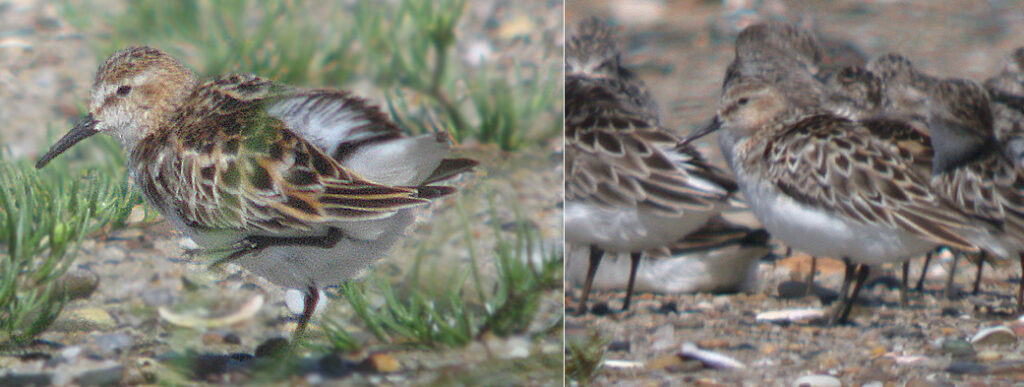
Photos by J. Trimble from July 23 and 24, respectively, suggest the possibility there were two stints involved.
Curlew Sandpiper (Calidris ferruginea), #04-28, September 17, 2004, Scituate (Plymouth), D. Furbish* et al. This species is reported practically annually in Massachusetts, with sightings concentrated in late spring and early fall. It is interesting that a breeding plumaged adult was reported at South Beach in Chatham in June of 2004, followed by another (?) adult between August 27 and September 7 at the same location. This molting adult was carefully described. (First ballot. Vote: 9-0)
Buff-breasted Sandpiper (Tryngites subruficollis), #05-20, July 10, 2005, Bolton Flats (Worcester), K. Hartel. Buff-breasted Sandpiper is an uncommon but regular fall migrant both along the coast and locally at inland locations; however, it is unprecedented in early July. This bird in adult plumage was carefully described. (First ballot. Vote: 8-1)
Black-tailed Gull (Larus crassirostris), #04-25, July 4, 2004, South Beach, Chatham (Barnstable), V. Laux*. This Asian larid has previously been reported from several locations along the Mid-Atlantic coast, with one report as close as Rhode Island and another in Nova Scotia, so its appearance in Massachusetts has long been anticipated. This basic-plumaged adult was carefully studied in comparison to several Lesser Black-backed Gulls (L. fuscus), and the observer specifically described its smaller size, slightly paler mantle, distinctive bill coloration, and broad, black, terminal tail band. This would have been a true Independence Day celebration had not nearby boaters set off a volley of fireworks that flushed all the gulls just before the observer was able to show it to a group of nearby tern wardens. This is a first Massachusetts state record. (First ballot. Vote: 8-1)
Franklin’s Gull (Larus pipixcan), #05-28, August 6, 2005, Chatham South Beach (Barnstable)V. Laux*, P. Trimble† (First ballot. Vote: 9-0). #05-29, August 20, 2005, Westport (Bristol), M. Lynch* (First ballot. Vote: 9-0). The Chatham bird was seen only briefly, but it was well described definitively photographed with a “point and shoot” camera. In Westport, observers were able to obtain excellent views, both at rest and in flight, with nearby Laughing Gulls for comparison.
California Gull (Larus californicus), #05-01, January 3-18, 2005, Nantucket (Nantucket), F. Gallo*, P. Dugan, many photographers†. (First ballot. Vote: 9-0). #05-07, April 29-May 5, 2005, Lynn/Nahant (Essex), J. Quigley*, C. Marantz*, J. Berry*.Many photographers†. (First ballot. Vote: 9-0). Prior to 2005 there were only two records of California Gull in Massachusetts. Then in 2005, a first winter California Gull was discovered resting in a mixed flock of gulls on a farm field at Nantucket, where numerous observers were able to see and photograph over more than two-week period. A second California Gull in adult plumage was seen and photographed by many at Lynn Beach.
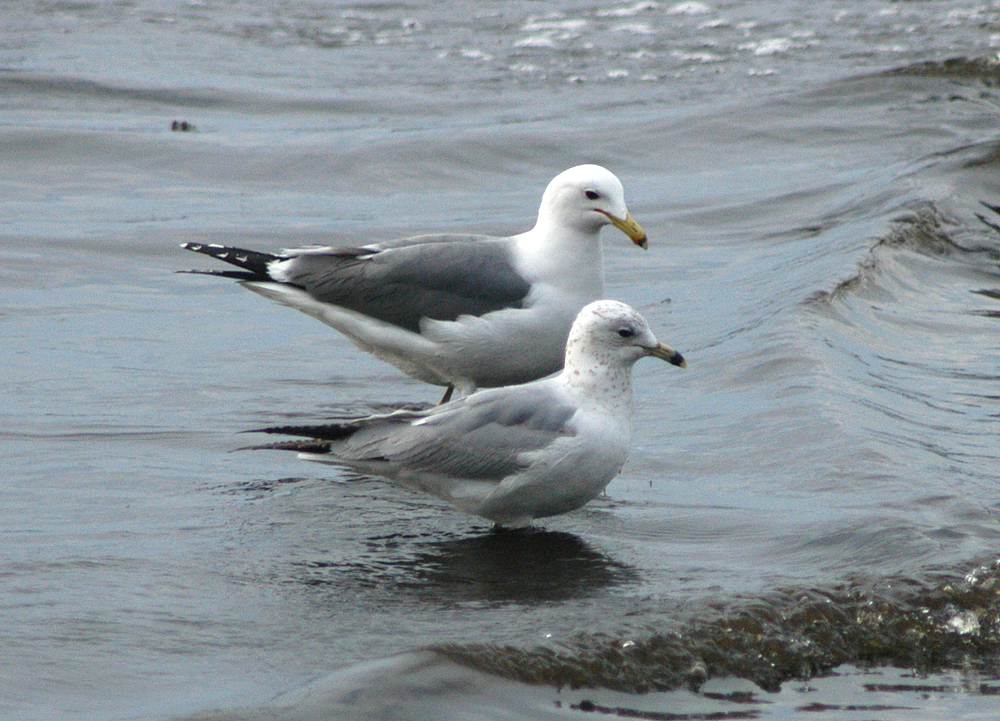
The Lynn CAGU by J. Trimble, with a nice comparison to a Ring-billed.
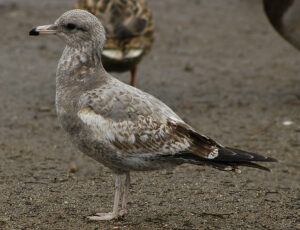
January 3-18, 2005, Nantucket. Photo by Jeremiah Trimble.
Forster’s Tern (Sterna forsteri), #05-04, January 2, 2005, Freetown (Bristol), J. Berry* et al. Sterna species in Massachusetts rarely linger past November and there are only four previous January sightings of Forster’s Tern in the state prior to this report. Observers carefully noted the distinctive face pattern of this winter-plumaged bird. (First ballot. Vote: 9-0)
Sandwich Tern (Sterna sandvicensis), #05-19, July 21, 2005, Chatham South Beach, N. Bonomo, R. Merrill*†. Sandwich Terns are almost annual visitors to Massachusetts, and practically all occur on Cape Cod and the Islands. This individual was well described and photographed. (First ballot. Vote: 9-0)
European Turtle-Dove (Streptopelia turtur), #01-27, July 20, 2001, Tuckernuck Island, R. Veit, N. Brewer. A dead bird discovered as a road kill on Tuckernuck Island was fortunately shown to an ornithologist who recognized it as a European Turtle-Dove. Following an examination of specimens at the American Museum of Natural History, it was determined that the bird belonged to the nominate subspecies, S. t. turtur, the race that occurs in Britain and Western Europe and is a frequent vagrant to Iceland. There are only two previous North American records of this species, the first in Florida in 1990, and the second in Newfoundland in May of 2001. The specimen of this first Massachusetts record is now in the Museum of Comparative Zoology at Harvard University. (First ballot. Vote: 8-1).
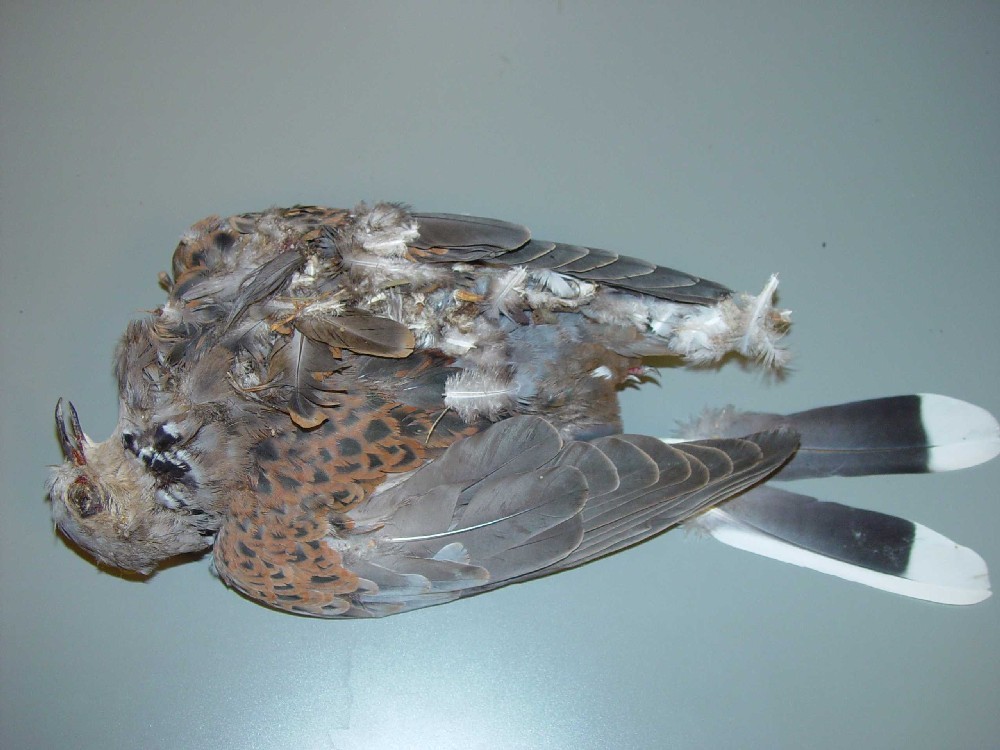
July 20, 2001, Tuckernuck Island
White-winged Dove (Zenaida asiatica), #04-29, November 23 to December 31, 2004, Nantucket (Nantucket), F. Karttunen* et al. (many photographers†) (First ballot. Vote: 8-1) #05-09, 4/22-5/1, Mount Auburn Cemetery, Watertown, R. Stymeist et al. (many photographers†) (First ballot. Vote: 9-0). The Nantucket individual was visiting a feeder and was photographed and seen by many. The Watertown bird was discovered at Mount Auburn Cemetery at a time of year when hundreds of birders visit the cemetery every day, so it was seen and photographed by many dozens of observers. The majority of roughly twenty previous Massachusetts reports of White-winged Dove have been from outer Cape Cod and the I Islands, so the Mount Auburn location was exceptional.
Large Swift Species, #05-16, May 28, 2005, North Truro (Barnstable), B. Nikula* et al. Observers at a Cape Cod hawk watch site were having a slow morning until they saw a large swift approaching from the south, at which point three of the observers followed it intently as it continued past them to the northwest and disappeared out of sight. One observer thought it was paler on the side of the throat, but another believed this might have been an illusion created by reflected light. All observers agreed, however, that it was larger than any Chaetura swift ( e.g., Chimney Swift), with longer wings and slower wing beats. Given the brief view (as well as the differences in perception of the throat markings), it was impossible for the observers to identify the swift to genus, so the sighting remains one of those tantalizing and frustrating sightings similar to another “Large Swift Species” seen in July of 1996 at Chappaquiddick (see MARC Report #4, Bird Observer, Vol. 28, Number 1). (First ballot. Vote: 8-1)
Rufous Hummingbird (Selasphorus rufus), #04-31, November 10 to December 15, 2004, Ashfield (Franklin), E. Stewart, M. Szantyr†* et al. (First ballot. Vote: 9-0). #05-30, October 8-19, 2005, Byfield (Essex), R. Crist, P. Brown*† (First ballot. Vote: 8-1). A hatch-year male was netted and banded at a feeder in Ashfield, and measurements and photographs in the hand showed conclusively that the bird was a Rufous Hummingbird. Efforts to catch another hatch-year male at a feeder in Byfield were unsuccessful, however photographs taken of the bird spreading its tail clearly conclusively showed R5 (i.e., the fifth rectrix) to be wide and rounded, unlike the narrow and pointed R5 of the very similar Allen’s Hummingbird (S. sasin), a species that has also been previously recorded in Massachusetts.
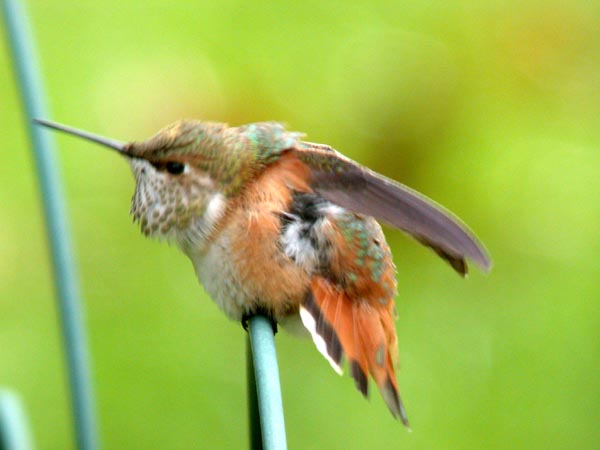
The Byfield Rufous, spread-tail, by P. Brown.
Selasphorus species, #05-31, September 19-21, 2005, Princeton (Worcester), D. + J. Choiniere*†. Homeowners noticed an unfamiliar hummingbird visiting their feeder, larger and more “orangey” than the Ruby-throateds that were still frequenting feeders in the yard. Photographs taken of the bird clearly indicated that it was a Selasphorus hummingbird. (First ballot. Vote: 9-0)
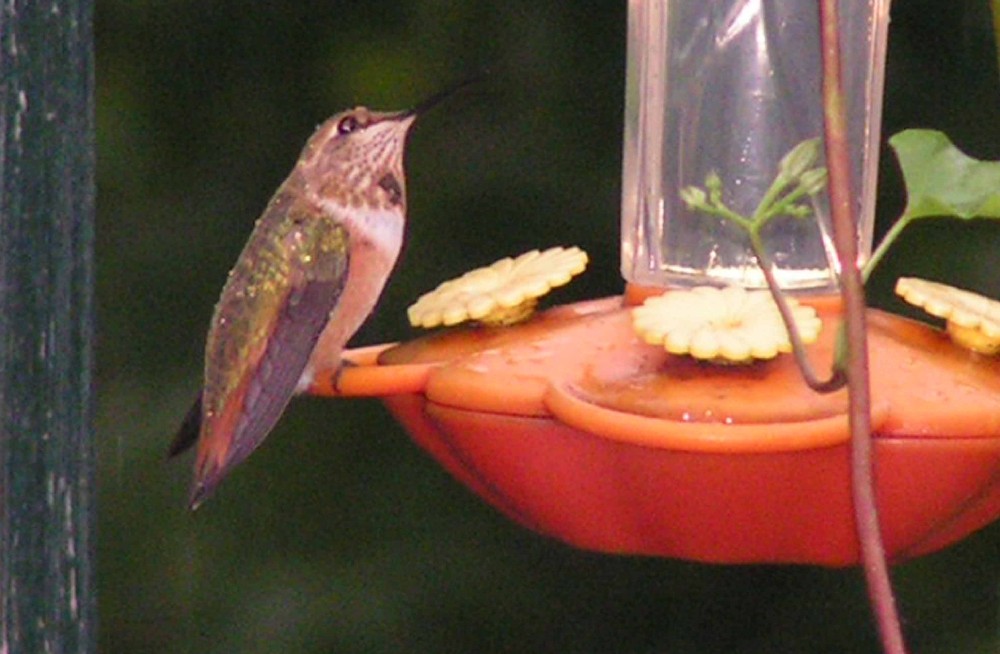
Photo by J. Choiniere.
Ash-throated Flycatcher (Myiarchus cinerascens), #04-30, November 26 to December 19, 2004, Rockport (Essex. Vote: 9-0), T. Burke, J. Berry*, T. Spahr*, B. Volkle*, P. Brown† et al. (First ballot) #05-22, May 20, 2005, Hingham (Plymouth), G. d’Entremont* (First ballot. Vote: 8-1). Birds of Massachusetts (Veit and Petersen, 1993) cites only eight records of this species, but since the publication of that reference no fewer than a dozen more have been reported. All but three previous state records have been in November and December, and there is only one previous spring record.
Western Kingbird (Tyrannus verticalis), #04-40, December 17, 2004, Northampton (Hampshire), L. Therrien.* Although Western Kingbird is a relatively routine visitor in the fall, most sightings are from coastal locations between September and November. The MARC Bylaws state “species that are geographically or temporally rare will be evaluated at the discretion of the Committee,” and this sighting falls into both categories. (First ballot. Vote: 9-0)
Fork-tailed Flycatcher (Tyrannus savana), #05-11, May 18, 2005, Nantucket (Nantucket), S. Finley, K. Blackshaw†. While no details were submitted, unambiguous photographs of this bird were posted on the Internet. (First ballot. Vote: 9-0)
Bell’s Vireo (Vireo bellii), #05-32, October 24-26, 2005, Manomet (Plymouth), A. Graham, B. Flemer, T. Lloyd-Evans, et al. With three previous reports in New Hampshire and another in Connecticut, this species has seemingly been long overdue in Massachusetts. A hatch-year bird of unknown sex that was fortuitously captured in a mist net and carefully measured and photographed, presented the Committee with unambiguous proof of its occurrence in Massachusetts. The vireo was actually mist-netted twice, once on October 24, and then again on October 26, but never seen in the field. It was definitively photographed in the hand. (First ballot. Vote: 9-0)
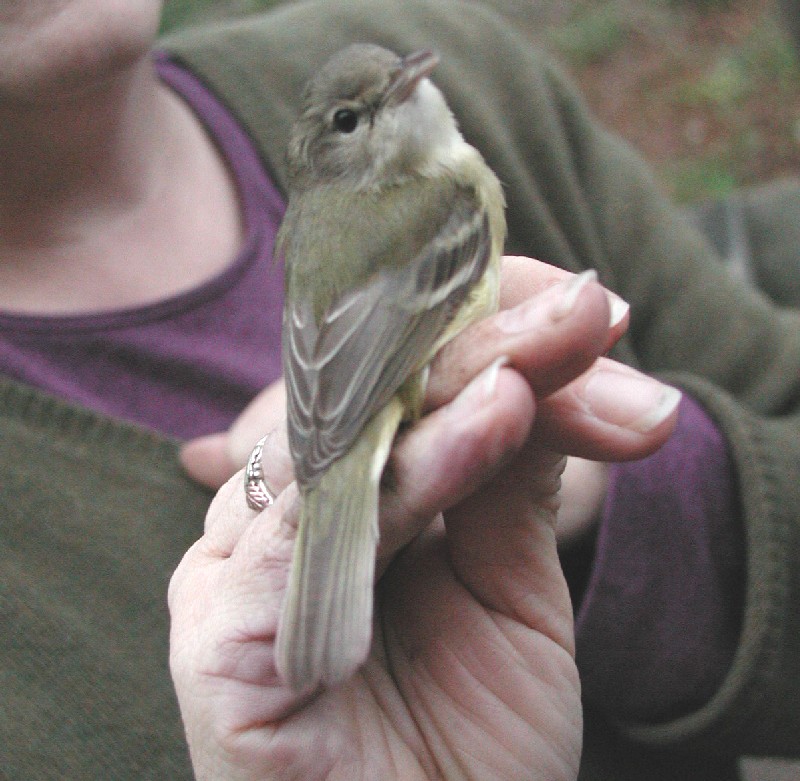
Manoment, 2005
Cave Swallow (Petrochelidon fulva), #04-35, November 26, 2004, Cotuit (Barnstable), J. Trimble* et al. (First ballot. Vote: 9-0). #04-36, November 27, 2004, Chatham (Barnstable), J. Trimble† et al. (First ballot. Vote: 9-0). The first and long-anticipated record of Cave Swallow in Massachusetts occurred in November of 2003 following reports from coastal Rhode Island and Connecticut during November of previous years. This could herald an increasing trend, since Cave Swallows are appearing with increasing frequency on the Mid-Atlantic Coast, and the observers who discovered the birds this year specifically made a point of looking for them following favorable conditions for the second year in a row.
Northern Wheatear (Oenanthe oenanthe), #04-37, October 1-3, 2004, Plymouth Beach (Plymouth), J. Walter, P. Brown†. Although no written report was submitted for this report, photographs published on the Internet were diagnostic. (First ballot. Vote: 8-1)
Townsend’s Solitaire (Myadestes townsendi), #04-16, November 27, 2004, Eastham (Barnstable), J. Hoye and A. McCarthy* (First ballot. Vote: 8-1). #04-34, December 19, 2004, Gloucester (Essex), S. Hedman*, B. Volkle* (First ballot. Vote: 9-0). There are roughly a dozen records of this western vagrant in Massachusetts, all of them in winter. In general these birds tend to linger throughout the winter, affording many birders the opportunity to see them. However, no doubt due to their somewhat retiring behavior and habit of foraging deep in thickets and cedar groves, these individuals were never relocated.
Varied Thrush (Ixoreus naevius), #05-02, January 15 to March 10, 2005, Mendon (Worcester), G. Christianson, M. Lynch and S. Carroll*. A male visiting a feeder was one of a small irruption of Varied Thrushes in the winter of 2004-2005. Other undocumented individuals were reported from Newburyport, Concord, Sheffield, Nantucket, and Oak Bluffs. (First ballot. Vote: 9-0)
Townsend’s Warbler (Dendroica townsendi), #04-17, December 19, 2004, Rockport (Essex), M. Goetschkes, I. Giriunas*. (First ballot. Vote: 8-1) #05-15, May 5, 2005, Ipswich (Essex), A. Burke* (First ballot. Vote: 8-1). The Rockport bird was discovered on the Cape Ann Christmas Bird Count, when the observers carefully noted the streaked yellow breast and the bold black eye patch set against a bright yellow face, thus eliminating other “look-alike” Dendroica warblers. The Ipswich bird was accompanied by few details, but an excellent accompanying field sketch showed all pertinent field marks. There are fewer than ten prior records for this western vagrant for Massachusetts.
Hermit Warbler (Dendroica occidentalis), #04-33, November 29-30, 2004, Holyoke (Hampden), L. + A. Richardson* et al. Two experienced observers following a noisy feeding flock of birds noted a small bird showing some yellow, and when they got a close look they were stunned to see the unmarked bright yellow head of a Hermit Warbler. They carefully noted all field marks and made a field sketch as soon as they returned to their car while impressions were still fresh in their minds. This is only the third record of this handsome western warbler for Massachusetts. (First ballot. Vote: 9-0)
Chestnut-collared Longspur (Calcarius ornatus), #04-18, December 15, 2004, Plum Island (Essex), D. Weaver†*, B. Gette*. A field trip group from the Joppa Flats Education Center was watching a small flock of American Tree Sparrows foraging at the edge of the road, when the group noted a different bird having a reddish-brown hind neck. The logical conclusion was that the bird was a Lapland Longspur, but when turned, it showed a buffy face and throat and black belly. As one observer consulted a field guide and called out field marks, the rest of the group confirmed the identification of the bird as Chestnut-collared Longspur. Photographs further confirmed this identification. This is only the fifth record of this prairie species for Massachusetts. (First ballot. Vote: 9-0)
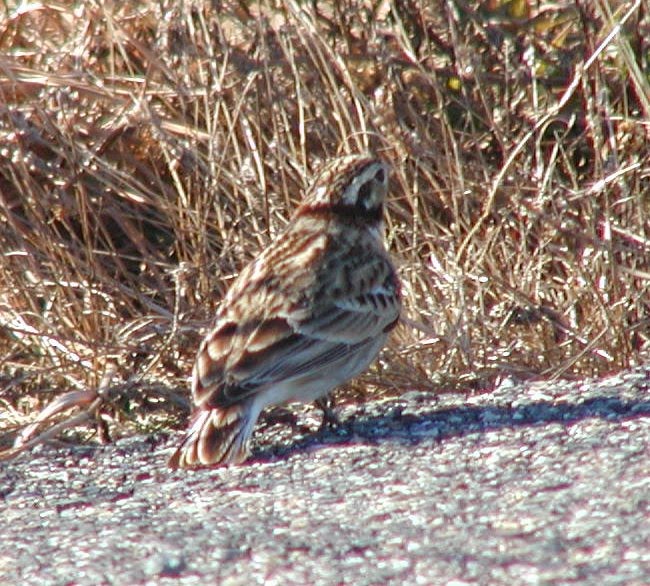
Photo by D. Weaver
Bullock’s Oriole (Icterus bullockii), #03-42, December 27-31, 2003, Walpole (Norfolk), W. Barnes†. A single small photo was the only documentation submitted for this record. While it clearly depicted a female oriole, some members felt that the quality of the image was not sufficient to eliminate a Baltimore or a Baltimore X Bullock’s Oriole hybrid. Nonetheless, after considerable discussion, all members voted to accept the report. (Third ballot. Vote: 9-0)

Photo by W. Barnes.
Records not accepted by the MARC
Barnacle Goose (Branta leucopsis), #05-05, March 29-31, 2005, Bolton Flats (Worcester). The identity of this goose was not in question, but since it was associating with a goose that was thought by many to be a hybrid Barnacle x Canada Goose (B. canadensis), or possibly an aberrantly plumaged Canada Goose its origin was considered suspect. Although the time of year was seemingly appropriate for the bird to be a Barnacle Goose of wild origin, the Committee believed that its association with the aberrant goose raised a legitimate question about its provenance. (Second ballot. Vote: 4-5)
Pacific Loon (Gavia pacifica), #04-27, November 17, 2004, Barnstable (Barnstable). The fact that this bird was seen only in flight caused some members to vote against this report. (Second ballot. Vote: 4-5)
Magnificent Frigatebird (Fregata magnificens), #03-09-R, September 27, 2003, Marblehead (Essex). This record had been previously submitted to the MARC when it was accepted only as “Frigatebird species” because details did not conclusively eliminate other species, however unlikely they might be (see MARC Report #8, Bird Observer Vol. 32, Number 2). Subsequently another observer submitted details in support of the same bird, but once again the Committee felt that the details failed to eliminate other Fregata species. (Second ballot. Vote 4-5)
Pacific Golden-Plover (Pluvialis fulva), #04-32, September 11, 2004, Chappaquiddick (Dukes). The description of an individual in juvenile plumage stressed the short primary length as well as the overall color. Several Committee members commented that they would always demand to see photographs in order to vote for a bird in this plumage, since descriptions of size, shape, and color are subjective even under the best of circumstances. (First ballot. Vote: 4-5)
Black-tailed Gull, (Larus crassirostris), #04-14, June 11, 2004, Lynn Beach (Essex). The description of this adult, dark-mantled gull was extremely interesting, and would have represented a first state record. Unfortunately the details submitted were deemed insufficient for such a rarity and after three ballots the report failed to achieve the minimum of eight votes required for acceptance. (Third ballot. Vote: 7-2)
Thayer’s Gull, (Larus thayeri), #04-38, November 23, 2004, Edgartown (Dukes). Details were determined to be too sketchy to confirm the identity of such a problematic species. (First ballot. Vote 1-8)
Eurasian Collared-Dove, (Streptopelia decaocto), 04-20, 8/22/04, Lynn Beach (Essex). The details on this report were insufficient to rule out the very similar Ringed Turtle-Dove (S. risoria), a species commonly kept in captivity. (First ballot. Vote 1-8)
Black-chinned Hummingbird (Archilochus alexandri), #05-26, August 28, 2005, Ashburnham (Worcester), A. Turner†. Photographs of a hummingbird with a suspiciously dark gorget were the only documentation on this submission. Although Committee members agreed it could have been a Black-chinned, there was nothing in the photos that would definitely rule out Ruby-throated. (First ballot. Vote 1-8)
Hoary Redpoll, (Carduelis hornemanni), #04-11, 3/10/04, Hinsdale (Berkshire). In the winter of 2004 there were an unusual number of Hoary Redpolls reported, but the details on this description of two individuals could not rule out Common Redpoll. (Third ballot. Vote: 6-3)
Current members of the MARC are Dennis Abbott, David Clapp, Davis Finch, Erik Nielsen, Blair Nikula, Wayne Petersen (Chair), Robert Stymeist, Scott Surner, and Jeremiah Trimble. Marjorie Rines is Secretary.
The author thanks Wayne Petersen for editorial assistance.
* Details submitted
† Photographs submitted or obtained on the Internet
